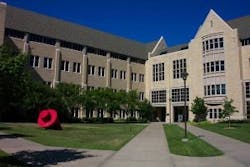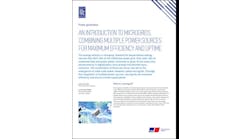$2.1 Million Campus Microgrid Addresses Sustainability Goals Outlined by Pope Francis and Other Quick News
Work to Begin on $2.1 Million Campus Microgrid at the University of St. Thomas in St. Paul, Minnesota
The Frey Science and Engineering Center at the University of St. Thomas. Source: Wikimedia Commons
The University of St. Thomas is committed to becoming a carbon neutral campus by 2035. It is also among the Catholic engineering schools from across the country whose deans pledged to drive activity on their campuses that directly address the goals outlined in Pope Francis’ encyclical Laudato Si.
St. Thomas’ School of Engineering reports that it will take an important first step towards these goals this summer, beginning work on a campus microgrid facility that will be used for teaching as well as research and testing distributed energy resources for alternative-energy microgrids.
The campus microgrid is expected to be fully operational in about three years. In 2017 it will be in island mode — operational but not connected to the power grid — and by 2018, it will be fully connected to the region’s power grid.
It will include 200 solar panels that can generate up to 50 kW, enough to power 10-15 suburban homes, generators powered by biodiesel and energy storage systems. These components will be housed in or on three adjacent buildings on the university’s south campus.
Instead of installing a large wind turbine on campus, the renewable energy facility will have a wind-turbine emulator, a device that for testing purposes mimics the power output of a real wind turbine.
“Companies developing and testing components for renewable and alternative energy systems will work directly with our students and faculty from the fields of software, engineering and the sciences, ” said Don Weinkauf, professor and dean of the School of Engineering.
Professor Greg Mowry, a St. Thomas School of Engineering professor with extensive experience with microgrid power systems, will oversee the center’s operation.
Funds for the facility come from a $2.1 million grant from the Xcel Energy Renewable Development Fund (RDF), a state-mandated grant program funded by Xcel customers. Grants are approved by the Minnesota Public Utilities Commission.
***
Smart Software for Smart Grids: Stem Expands Portfolio to 68 MWh, Closes $15 Million in Funding
Intelligent energy storage helps businesses automatically reduce electricity bills and efficiently manage daily energy use. Software-driven energy storage company Stem announced it has surpassed 68 MWh of systems operating and under contract and closed $15 million in funding Mithril Capital Management.
Stem’s expanded fleet – which includes batteries from Samsung and Panasonic as well as Powerpack battery systems procured from Tesla Energy – is now more than 40 percent larger than its closest competitor, according to the company.
“Integrating cleantech solutions at scale is an important goal but a huge challenge,” said Ajay Royan, co-Founder and managing general partner of Mithril. “You can’t have a truly smart grid until you have smart storage, and you can’t have smart storage without smart software. Stem’s technology creates a self-healing grid that increases efficiency and resilience through real-time co-optimization between generators, power users, and utilities….”
Stem combines big data, predictive analytics and energy storage to simultaneously reduce electricity costs for businesses and in aggregate, deliver services to the grid. Its software learns a customer’s unique energy profile to maximize savings and displays real-time and predicted energy use alongside actionable recommendations. When aggregated, Stem’s customer-sited storage network offers flexible, cost-competitive capacity to the grid.
Stem’s systems continuously improve as more data is collected, further strengthening the network as customers save. Stem’s network now includes more than 440 facilities in California and Hawaii and is informed by more than 2 million field runtime hours.
Mithril’s investment brings Stem’s Series C raise to $68 million, reinforcing Series C support from RWE Supply & Trading of Germany, Japan’s Mitsui & Co., and investors from previous rounds.
The company leads the industry in Fortune 500 firms under contract, working with customers such as Wells Fargo, Safeway, Whole Foods, and Reliance Steel. Its utility partners include Southern California Edison (SCE), San Diego Gas & Electric (SDG&E) and the Hawaiian Electric Company (HECO).
***
Get Your Microgrids Ready: Atlantic Hurricane Season May Be The Most Active in Three Years
Atlantic hurricane season is officially underway, and according to Accuweather.com, it is expected to be more active than any season in the past three years.
The 2015 Atlantic hurricane season yielded 11 named storms in total; 14 are forecast for this year. Meteorologists say it’s looking more and more likely that the El Niño weather pattern will transition to a La Niña pattern, increasing the potential for a higher-than-normal amount of tropical systems.
When extreme weather hits and the central power grid fails, islanding microgrids can come to the rescue by powering critical systems and facilities. Experts warn that those living along the Atlantic coast should be on alert.
Atlantic hurricane season runs from June 1 to Nov. 30. Get your microgrids ready.
***
Join us on Twitter @MicrogridNews for more campus microgrid news.







